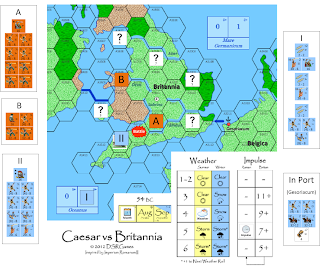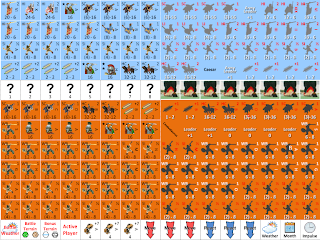I developed a combat system to handle battles that occur onboard that I don't want to handle with miniatures.
My goal was to create a flexible system where some tactical choices can be made to make battles interesting (rather than just an odds- based combat roll). What follows is a very generic overview.
The side that initiated the battle is the attacker (of course), and the other the defender (of course). Defending does not mean that he cannot counter-attack the attacker.
The way to defeat the enemy army is to reduce its Army Morale.
Both sides have a reserve of all units in the battle. These are composed stacks of units as they desire, up to limits (4 units if leader is in stack, 3 otherwise). This is done simultaneously and secretly before the battle is resolved. Stacks cannot be changed once battle has begun. This models the initial dispositions of the armies and stacks that take casualties can become very vulnerable.
Here's an example: of creating stacks from an army
 |
| Click to enlarge |
The original army composition is 1 leader, 1 Heavy Cavalry (HC), 2 Legions (HI), 1 Light Infantry (LI), and 3 Skirmish Infantry (SI). Note that only the HI and LI have reverse sides (e.g. when damaged they are reduced, not eliminated). Here are 3 different compositions (amongst many more possible).
Option A is a max combat stacking. The 1st stack is flexible enough to lead with HC or HI depending on what opposing stack it is facing. Both stacks have SI and LI to inflict/deflect incoming enemy missile troops. But if the enemy has 3 or more stacks, this setup will suffer from enemy flanking.
Option B is more of an attack with cavalry setup, and would work well if he can get the flanking bonus (applies if one side has more non-SI stacks than the other side), as he can keep the cavalry back and use for pursuit instead of direct combat).
Option C is a more balanced approach. The light stack could be used for outflanking purposes but the main punch is located in the other 2 stacks.
There are many permutations/combinations that can be made, allowing free reign of genius/idiot deployments that can influence a battle. You have enough leeway and rope to hang yourself or your enemy...
Continuing with the battle resolution:
Both sides check for initiative. The side with more scouting points (Skirmish, Light or Cavalry units counts for this) has a bonus to the iniative.
The side with initiative can choose one of 3 actions: Assault, Withdaw, Defend (defender only).
To Withdraw, it must pass a withdrawal roll. Failure to withdraw may cause army morale to slip.
A Defend allows the defender (only) to force the attacker to perform an assault, with the attacker allocating his stacks first.
An Assault is where the winner of the initiave chooses which stack(s) to assault which defending stacks.
Note: The assaulting/defending side does not have to use all its stacks. It can choose as many as it desires to use for that assault but must choose at least one.
For each stack battle, each side allocates a primary unit that will bear the brunt of the combat, while the rest are in support.
For each stack battle:
Missile fire is performed by both sides simultaneously and casualties (if any) are inflicted.
Combat is simultaneous unless the primary unit is a cavalry or elephant vs an infantry unit NOT across a river (called bonus terrain and applies to walls, amphibious landings etc). Terrain (obviously) influences this roll.
Effects from each stack battle are applied, and casualties taken.

After all stacks have fought a round of battle, each army takes an Army Morale check to see if their morale erodes. A side that winds up with more primary units destroyed is at a disadvantage.
Army morale for the loser is reduced. If it is reduced too far (or the difference between the rolls is too high) the losing side routs. If it is reduced to 0 or -1, the loser withdraws.
A routed side can be pursued by the winning side.
If neither army routs or withdraws, all stacks are returned to their respective reserves and both sides check initiative again, and the process continues.
To the right is the current battle-board that allows an easier appreciation of the battle structure (click to enlarge).
The combat system has a lot of other detail in it than described here, and it generates interesting battles where the largest army does not always win. And in the end, that is the point as minaiture games tend to be that way.




































